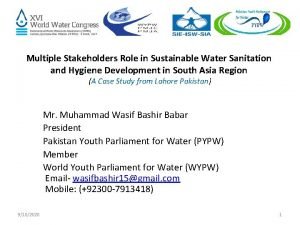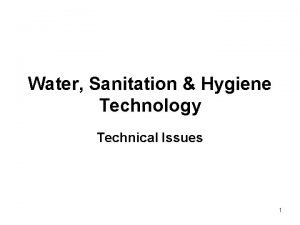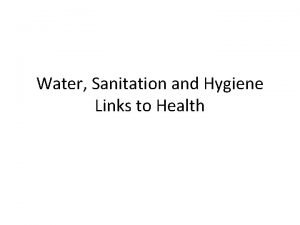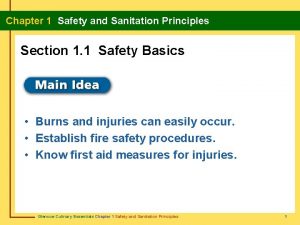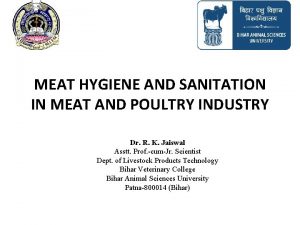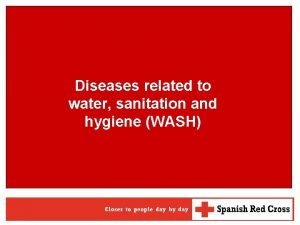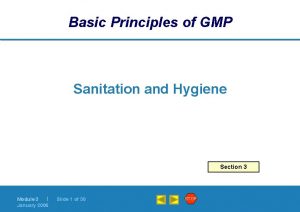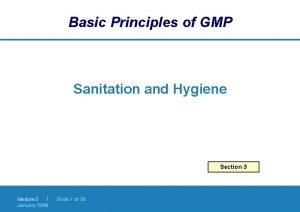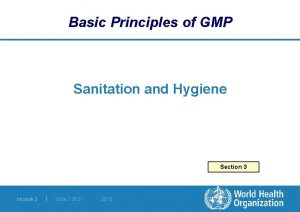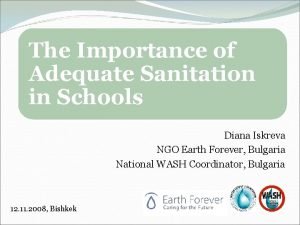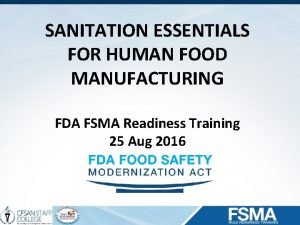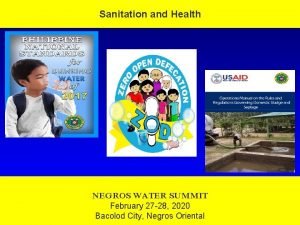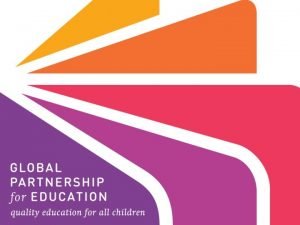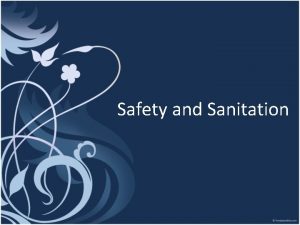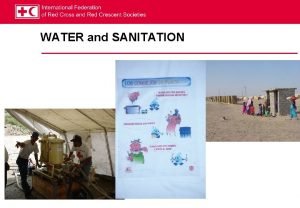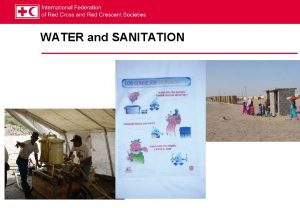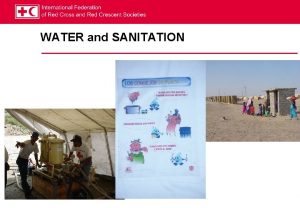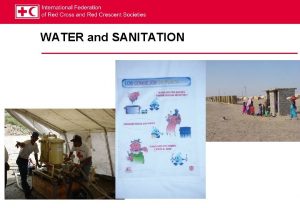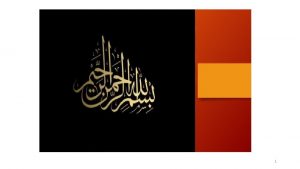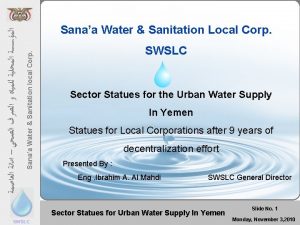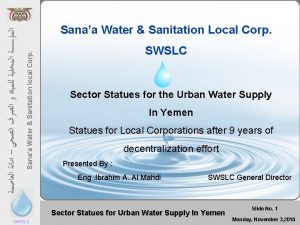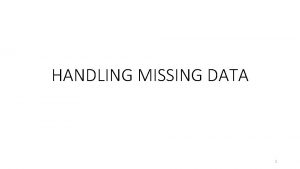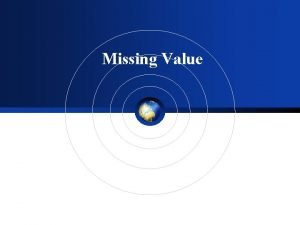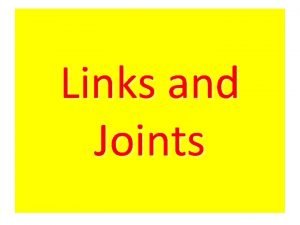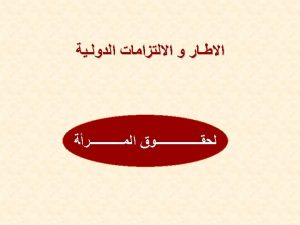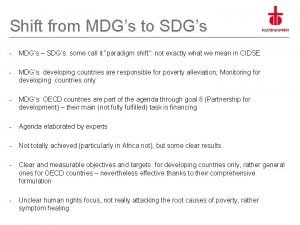Water and Sanitation MDGs Status achievements missing links

















- Slides: 17

Water and Sanitation MDGs: Status, achievements & missing links

The Big Picture ¡ ¡ 335 million Africans still without improved water, 498 million without sanitation To meet MDGs, nos. served should double, to 700 million by 2015 Even then, 200 million would remain unserved While Northern Africa (NA) is on track for both water and sanitation MDGs, sub. Saharan Africa (SSA) is off track for both.

Uneven & inequitable progress ¡ ¡ Worse in rural areas: in SSA 51% of rural population without water, 47% without sanitation Majority of target group is poor; women and girls bear most of costs Sanitation much worse than water: a neglected, unspoken crisis – but mainly an on-site, domestic issue Big country variations: in some, coverage actually declining, many others need to double or treble rate of increase

Financial costs of achieving MDGs In SSA, annual investment costs 2005 -2014 USD 4. 55 billion (WHO) ¡ Three-quarters of this is sanitation ¡ Inclusion of recurrent costs (O&M etc) would raise total to USD 9. 41 billion ¡ Cost depends on choices: level of service, technology, location of target group ¡

Service performance ¡ ¡ 100% continuity of service very rare Other key indicators – collections, staffing ratios, water losses etc – are unsatisfactory Many utilities don’t recover full operating costs, most don’t fund adequate maintenance. Much existing infrastructure deteriorating

Environmental sustainability ¡ ¡ ¡ Many existing water sources unsuitable or unhealthy Access to improved, well planned, source could relieve local environmental stress But extending coverage to large populations could aggravate pressure on water resources Drilling new wells could leave existing wells high and dry In some regions MDGs entail use of contaminated groundwater However, existing sanitation practices polluting and a health hazard

Beyond 2015 ¡ ¡ Accomplishment of MDGs would still leave 200 million Africans unserved African Water Vision 2025: a glimpse of the ideal Meanwhile, a difficult period after 2015 – “low hanging fruit” already picked, least privileged populations remaining Choices to be made between universal coverage to basic level, and higher standards for some

Rural W&S: a case apart? ¡ ¡ ¡ Logistics of getting finance & materials to outlying regions: “turning money into water”; High rate of breakdown & non-functionality Overlap between domestic & agro water use The gender dimension Sanitation: organisation & finance a household affair, with community pressure RWSSI target: 66% rural access to W&S by 2010, 80% by 2015

MDG progress: success factors ¡ ¡ ¡ Governments “own” and drive reforms Links between water, sanitation, poverty & growth understood & reflected in policy Civil society bodies are effective advocates & involved in policymaking Active reforms of water sector undertaken Decentralisation of responsibility is “bedded in” and working Ministerial responsibilities clear, coordinated & functional

MDGs: reasons for lack of progress ¡ ¡ ¡ ¡ External agents the main drivers of change NGO activities off-budget & weakly coordinated Poor understanding of wider linkages of W&S, weak implementation capacity Urban bias & neglect of rural areas Sanitation & hygiene neglected & lagging Uncoordinated & unclear Ministerial responsibilities Water utilities unreformed

Missing links: 1. Political leadership & country ownership Clear identification of ministerial responsibilities & champions of W&S ¡ Make full use of evidence of watsan benefits for advocacy ¡ Target key decision makers outside water world (e. g. Finance) ¡ Role for AMCOW in peer group influence (plus sanitation ministers) ¡

Missing links 2: connect W&S with hygiene, health & poverty Watsan is central to anti-poverty strategies ¡ Get W&S into PRSPs ¡ Target medical profession & Ministries of Health for dialogue & cooperation ¡

Missing links 3: Knowledge & analytical gaps ¡ ¡ Differentiation of MDG target groups: more detailed mapping Scenarios for MDG implementation: scope & impact of choices over target group, level of service, hardware What works, where: pooling of experience of governments, agencies, NGOs, esp. in fragile states & conflicts Planning for post-2015

Missing links 4: Financial gaps ¡ ¡ ¡ Larger national budgets & higher external aid – yes, but first improve channels to enable better use of existing flows Promote funding for sub-sovereign & decentralised agencies, where service responsibilities lie Tap into local sources of funds with financial innovation & risk sharing Greater cost recovery from users ODA should be more “fit for purpose” (e. g. use of common modalities) Adequate funding for governance and IWRM

Missing links 5: engagement of other actors ¡ ¡ Public utilities: weak capacity to expand services: need “rules of engagement” & reform agenda Local business (informal & small/medium scale) to be recognised & involved Framework foreign operators? Clarity of policy, regulation, pro-poor contract clauses NGOs in policy & administrative vacuum: more involvement required

Missing links 6: users & general public ¡ ¡ ¡ Providers not fully accountable to present, or missing, customers: more demandresponsiveness, transparency & social accountability needed In sanitation, more understanding & promotion of demand: subsidies to be targeted & sparingly used Policy space for variety, innovation & competition in delivery models: use of Global Fund for Sanitation, challenge funds, etc.

Finally… Africa as a whole off-track for the MDGs ¡ Though some concrete progress and many positive achievements ¡ But no Silver Bullets or Quick Fixes ¡ A challenging agenda ahead ¡ But forces of momentum and synergy will kick in once changes start ¡
 Water and water and water water
Water and water and water water Missing links quiz questions answers
Missing links quiz questions answers Stakeholders in water and sanitation
Stakeholders in water and sanitation Chapter 16-19 things fall apart
Chapter 16-19 things fall apart Sanitation and hygiene
Sanitation and hygiene Sanitation and hygiene
Sanitation and hygiene Chapter 1 safety and sanitation principles
Chapter 1 safety and sanitation principles Poultry hygiene and sanitation
Poultry hygiene and sanitation Sanitation and hygiene
Sanitation and hygiene Cleaning and sanitation manual for breweries
Cleaning and sanitation manual for breweries Gmp sanitation and hygiene
Gmp sanitation and hygiene Gmp sanitation and hygiene
Gmp sanitation and hygiene Gmp sanitation and hygiene
Gmp sanitation and hygiene Compendium of sanitation systems and technologies
Compendium of sanitation systems and technologies Sanitation importance
Sanitation importance Delvic sanitation initiatives
Delvic sanitation initiatives Ssop checklist
Ssop checklist Environmental sanitation clearance
Environmental sanitation clearance


